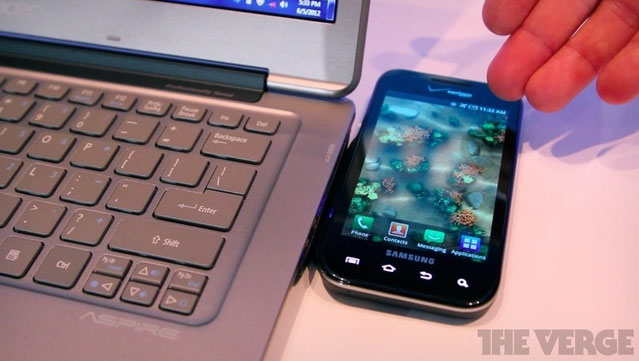Wireless chargers: updates, work principles and good news

In the rapid flow of information about the recently completed Computex 2012 exhibition, two news remained unnoticed, deserving, in our opinion, the best share - and not only because they are directly related to Intel, but ... well, let's talk about this in the final part .
In the meantime, let me introduce you to two options for using wireless charging technologies - as the company sees them.
Ultrabook as a charger

The first solution to which we would like to draw your attention is the wireless charging module built into the ultrabook. Wireless chargers have long been no news, but their introduction into our daily life is still sluggish. Intel's new solution will allow technology to move to the masses, because from now on, any ultrabook can be equipped with a charger, and the more ultrabooks there are, the easier it is to find a charger. Simply enough to bring a compatible device to the end of the ultrabook, where the charge is located - and the process has started.
Photos and videos taken from The Verge .
According to the developers, the charging module is compact enough not to disturb the slim lines of the ultrabook, but, on the other hand, it can generate up to 3 watts of “wireless electricity”, which should be sufficient to charge any type of mobile device. For the transmission of energy used induction method.
Recall that the induction mode of transmission uses the effect of electromagnetic induction, opened by Faraday 100 years before the mobile era. The principle of its operation can be briefly described as follows. The leading induction coil is connected to an alternating current source, under the action of which an alternating magnetic field arises around it. If a driven coil is brought into this field, an alternating current will arise in it, which after rectification is fed into the battery charging circuit of the mobile device. In recent years, this method has become widespread in household appliances due to its simplicity and high efficiency: now toothbrushes and flashlights are charged without wires, and induction cookers do very well without heat carrier to heat food.
Now let's consider wireless charging technologies applied to computer peripherals - there they also have something to do.
')
What I work with, from what I charge
Traditionally, computer mice and keyboards operate on batteries or rechargeable batteries, sometimes with their own recharging system. Meanwhile, the low mobility of these accessories makes them ideal for the introduction of wireless charging technologies, which was shown at Intel's Computex 2012.
Take a look at this monoblock computer. There is nothing surprising in it - it is now difficult in principle to surprise people with monoblocks. But the keyboard, the right, is remarkable. In the working position, it is moved away from the monitor at a comfortable distance for the user and works as a standard peripheral device. But it is necessary to bring it to the base of the monitor, the charging process begins, the indicator of which is a special light.
Photo and video taken from the site, Engadget .
The physical basis of energy transfer in this case is the same induction, but used in conjunction with another well-known whole phenomenon - resonance, which is why the method is called magnetic resonance. The essence of technology is as follows. The source resonator creates an alternating magnetic field of high frequency, when introduced into which the capture resonator, an alternating current is induced in it. The use of resonators allows you to increase both the maximum distance between the receiver and transmitter, and the transmitted energy. Adherents of technology proclaim the soon ubiquitous distribution of "home wireless power grids", which will include all household electrical appliances in the apartment. Maybe it will be so - if the “home” magnetic field turns out to be safe for our health. In any case, the low-power resonant transmitter used in the Intel keyboard will surely not harm anyone.

Good news
Where, finally, the promised good news? Obviously, they are not about those specific devices that are presented by Intel at the exhibition - they are unlikely to turn our world. Even the Siemens induction car, which is in the first picture, will probably not be able to do this. The good news is that wireless power transmission technologies are finally appearing in the performance of the market flagships.The mass distribution of wireless storage devices in the wide consumer market is delayed, lagging behind the needs of the mass user. The greater the importance of mobile devices in our lives, the angrier we become from the wires and charges that surround us in an apartment and office, which tend to get lost at the most inappropriate moment, forget about hiking and traveling, break down ... Nevertheless, the real charging time without wires, with all its apparent uniqueness - no more than accessories for geeks, with a bunch of restrictions, incompatibilities and other childhood diseases. It takes a strong hand to not only make the device more perfect, but also to overcome the conflicts of interests of market players. Intel could well become such a hand, with its currently pronounced strategic focus on the mobile device segment and a lot of experience resolving the intricate tangles of ideological and technological problems - if it continues to work in this direction.
It seems that users from this scenario will only get better.
Source: https://habr.com/ru/post/147970/
All Articles